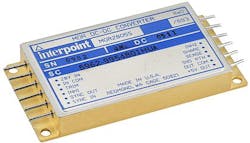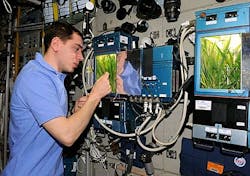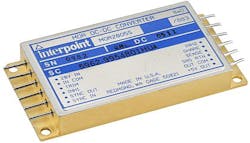NASA researchers look to Crane Aerospace to provide power electronics for space garden
KENNEDY SPACE CENTER, Fla., 3 April 2013. Botanical researchers at the NASA Kennedy Space Center, Fla., needed DC-DC converter power supplies and electromagnetic interference (EMI) filters for a prototype celestial plant garden on the International Space Station. They found their power electronics solution from Crane Aerospace & Electronics in Redmond, Wash.
NASA officials announced their intention last week to award Crane a sole-source space electronics contract for Interpoint-brand dual- and single-output DC-DC converters, as well as EMI filters, for the Plant Habitat prototype unit, which is to go aboard the space station.
The Plant Habitat is configured as a space station payload measuring about 21 inches high, 36 inches wide, and 24 inches deep that is expected to use about 735 Watts of power, NASA officials say. The Plant Habitat will help NASA researchers plan for long-duration manned space missions beyond low-Earth orbit.
The ability to grow plants on future deep-space missions may help provide food and breathable air on long space missions lasting months at a time, NASA officials say.
| Related stories -- Surviving the space environment -- Powering energy-efficient embedded systems in a cluttered environment -- New high-current EMI filters released by Crane Aerospace & Electronics. |
NASA plans to buy from Crane 20 dual-output Interpoint MOR2815DW DC-DC converters, six single-output Interpoint MOR2812SW DC-DC converters, and nine Interpoint FMCE1528W EMI filters for the Plant Habitat prototype. The value of the contract has yet to be negotiated.
The contract is being awarded sole-source to Crane because NASA has been designing the Plant Habitat prototype with the Interpoint power electronics parts, and Crane is the only company able to provide these kinds of converters and filters, according to NASA market research.
Engineering work such as electrical schematics and circuit board drawings have been completed based on the Interpoint products to ensure interoperability, NASA officials say, pointing out that switching to another product would require the costly and time-consuming rework of all the drawings and schematics.
The Plant Habitat will provide a large, enclosed, environmentally controlled chamber designed to support commercial and fundamental plant research onboard the space station, NASA officials say. The Plant Habitat's design includes the ability to control temperature, humidity, carbon dioxide levels, and LED lighting.
The science carrier has a water-delivery mechanism and a standard interface plate that will provide instrumentation support as part of the basic Plant Habitat capabilities. Plant habitat investigations can use the microgravity of space and can run 30, 60, or 90 days depending on the nature of the research.
The Plant Habitat will launch to the space station on a SpaceX Dragon spacecraft in December 2015, NASA officials say.
For more information contact Crane Aerospace & Electronics online at www.interpoint.com, or NASA Kennedy Space Center at www.nasa.gov/centers/kennedy.


